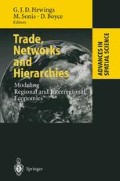Abstract
The renewed interest in international trade has drawn attention to the phenomenon of vertical specialization, the use of imported inputs for producing goods that are exported (see Bruelhart and Hine, 1999). Balassa (1967, p.97) coined the term, vertical specialization; in a recent paper, Hummels et al, (1998) introduced and discussed the following definition of vertical specialization:
(1) a good must be produced in multiple sequential stages, (2) two or more countries must specialize in producing some, but not all, stages, and (3) at least one stage must cross an international border more then once… Thus, countries link sequentially to produce a final good.
An earlier, abbreviated version of this chapter appeared as Sonis et al., 2000.
Access this chapter
Tax calculation will be finalised at checkout
Purchases are for personal use only
Preview
Unable to display preview. Download preview PDF.
References
Balassa, B. 1967. Trade Liberalization among Industrial Countries. New York, McGraw Hill.
Bruelhart, M. and R.C. Hine, eds. 1999. Intra-industry Trade and Adjustment. New York, St. Martins Press.
Christofides, W. 1975. Graph Theory: An algorithmic Approach. New York, Academic Press.
Dantzig, G.B. 1963. Linear Programming and Extensions. Princeton University Press.
Defourny J. and E. Thorbecke. 1984. “Structural Path Analysis and Multiplier Decomposition within a Social Accounting Matrix Framework.” Economic Journal, 94, 111–136.
Gower, J.C. 1977. “The analysis of symmetry and orthogonality.”. In J.R. Barra, ed. Recent Developments in Statistics. Amsterdam, North Holland. pp. 109–123.
Feinberg, S. 1970. “An Iterative Process for Estimation of Contingency Tables.” Annals of Mathematical Statistics, 41, 907–917.
Hewings, G.J.D., P.R. Israilevich, Y. Okuyama, D.K. Anderson, G.R. Schindler, M. Foulkes and M. Sonis. 1997. “Returns to scope, returns to trade and the structure of spatial interaction in the US Midwest,” Discussion Paper 97-P-3, Regional Economics Applications Laboratory, University of Illinois, Urbana.
Hewings, G.J.D., M. Sonis, J. Guo, P.R. Israilevich and G.R. Schindler. 1998. “The Hollowingout Process in the Chicago Economy, 1975–2011.” Geographical Analysis, 30, 217–223.
Hummels, D., D. Rappoport and K-M. Yi. 1998. “Vertical Specialization and the Changing Nature of Word Trade.” Federal Reserve Bank of New York, Economic Policy Review, June 1998.
Jurcat W.D. and H.J. Ryser. 1967. “Term Ranks and Permanents of Nonnegative Matrices.” Journal of Algebra, 5, 342–357.
Krugman, P. 1991. “Is Bilateralism bad?” In E. Helpman and A. Razin, eds. International Trade and Trade Policy. Cambridge, MIT Press. pp. 9–23.
Krugman P. 1993. “Regionalism versus multilateralism: analytical notes.” In J. De Melo and A. Panagaria, eds. New Directions in Regional Integration. Cambridge University Press. pp.58–79.
Polenske, K.R. 1970a. “Empirical estimation of interregional input-output models: estimation of 1963 Japanese production.” American Economic Review, 60, 76–82.
Polenske, K.R. 1970b. “Empirical implementation of a multiregional input-output gravity trade model.” In A.P. Carter and A. Bródy, eds. Contributions to Input-Output Analysis. Amsterdam, North Holland.
Martins, E.B. 1993. “Notes on the construction of the 1992 Illinois input-output table.” Discussion Paper 93-T-2, Regional Economics Applications Laboratory, University of Illinois, Urbana.
Richardson, L.F. 1922. Weather Prediction by Numerical Process. Cambridge University. Press.
Slater, D.B. 1981. “Combinatorial Procedures for Structuring Internal Migration and other Transaction Flows.” Quality and Quantity, 15, 179–202.
Sonis, M. 1980. “Location Push-Pull Analysis of Migration Streams.” Geographical Analysis, 12, 80–97.
Sonis, M. 1982. “The Decomposition Principle versus Optimization in Regional Analysis — the Inverted problem of Multiobjective Programming.” In G.P. Chiotis, D.A. Tsoukalas, H.D. Louri, eds. The Regions and Enlargement of European Economic Community. School of Economics and Business Science, Athens.
Sonis, M. and G.J.D. Hewings. 1990. “The ‘Matrioshka Principle’ in the hierarchical decomposition of multiregional social accounting systems.” In L. Anselin and M. Madden, (eds. New Directions in Regional Analysis: Integrated and Multiregional Approaches. London, Pinter.
Sonis, M., J. Oosterhaven and G.J.D. Hewings. 1993. “Spatial Economic Structure and Structural Changes in the European Common Market: Feedback Loop Input-Output Analysis.” Economic Systems Research, 5, 173–184.
Sonis, M., G.J.D. Hewings and R. Gazel. 1995a. “The structure of multi-regional trade flows: Hierarchy, Feedbacks and Spatial Linkages.” The Annals of Regional Science, 29, 409–430.
Sonis, M., J.J.M. Guilhoto and G.J.D. Hewings. 1995b. “The Asian Economy: Trade Structure interpreted by Feedback Loop Analysis.” Journal of Applied Input-Output Analysis, 2, 24–40.
Sonis, M., G.J.D. Hewings, J. Guo and E. Hulu. 1997. “Interpreting Spatial Economic Structure: Feedback Loops in the Indonesian Economy, 1980–1985.” Regional Science and Urban Economics, 27, 325–342.
Sonis, M., G.J.D. Hewings, and S. Sulistyowati. 1997. “The Structure of the Indonesian Economy: A Generalized Structural Path Analysis.” Economic Systems Research 9, 265–280.
Sonis, M., G.J.D. Hewings, and Y. Okuyama. 2000. “Vertical Specialization and Interregional Trade: Turbulence Analogy and Feedback Loops Analysis of the Midwest Economy.” In H. Herrmann and J. Bröcker, eds. Spatial Change and Interregional Flows in the Integrating Europe. Heidelberg, Physica-Verlag.
Author information
Authors and Affiliations
Editor information
Editors and Affiliations
Rights and permissions
Copyright information
© 2002 Springer-Verlag Berlin Heidelberg
About this chapter
Cite this chapter
Sonis, M., Hewings, G.J.D., Okuyama, Y. (2002). Vertical Specialization and Interregional Trade: Hierarchy of Spatial Production Cycles and Feedback Loop Analysis in the Midwest Economy. In: Hewings, G.J.D., Sonis, M., Boyce, D. (eds) Trade, Networks and Hierarchies. Advances in Spatial Science. Springer, Berlin, Heidelberg. https://doi.org/10.1007/978-3-662-04786-6_19
Download citation
DOI: https://doi.org/10.1007/978-3-662-04786-6_19
Publisher Name: Springer, Berlin, Heidelberg
Print ISBN: 978-3-642-07712-8
Online ISBN: 978-3-662-04786-6
eBook Packages: Springer Book Archive

